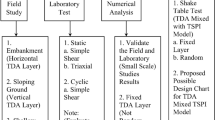The modern subway system has greatly alleviated the urban traffic congestion. However, it is difficult to avoid crossing paths with deformation-sensitive structures, such as high-speed railways and bridges, during subway construction. Based on the subgrade project of the Xulan High-Speed Railway under Xi’an Metro Line 1 in Shaanxi, China, this study performs numerical modeling to examine the dynamic load factors generated by high-speed railway operation and analyzes the disturbance and vibration effects of subway shield tunneling on soil layers with different stiffness. As the elastic modulus increases, the vibration response of the structure becomes weaker, which means that the disturbance effect on the soil becomes smaller. The refined simulation analysis of the highspeed rail dynamic load and shield tunneling provides valuable insight for theoretical application and engineering practice, especially regarding the management of disturbances caused by subway shield tunneling on surrounding structures.
Similar content being viewed by others
References
Q. C. Fang, L. Shang, and Y. H. Shang, “Study on the reinforcement measures and control effect of the surrounding rock stability based on the shield tunneling under overpass structure,” J. Eng. Sci. Technol. Rev., 9(1), 131–138 (2016).
L. Wang and Z. Yang, “Construction control technology of subway tunneling for underpass a viaduct,” Munic. Eng. Technol., 28(4), 101–104 (2010).
Y. Ji, J. Kang, and W. Yuan, “Numerical simulating analysis on impact of undercut electric power tunnel to underpass existing subway on subway and soil layer deformation,” Urban Roads Bridges Flood Control, 6, 269–271 (2013).
W. Gong, L. Zhe, and C. H. Juang, “Optimization of site exploration program for improved prediction of tunnelinginduced ground settlement in clays,” Comput. Geotech., 56, 69–79 (2014).
F. Chen, Y. C. Wang, W. Jiang, and S. H. Zheng, “Numerical simulation of ground movement induced by water and sand gushing in subway through fault based on DEM-CFD,” Comput. Geotech., 139, 104282 (2021).
Y. Xu, B. Tang, and Y. Duan, “Research on surface settlement of subway station construction using pile-beam-arch approach,” IOP Conf. Ser.: Earth Environ. Sci., 455(1), 012167 (2020).
Q. Y. Zhu, G. L. Ye, and J. H. Wang, “Long-term settlement and construction disturbance during shield tunnel in soft ground,” Chinese J. Geotech. Eng., 32(2), 509–512 (2010).
Y. Yuan, L. I. Su, and S. Han, “Study on subway station excavation concerning soil disturbance,” Constr. Technol., 48(1), 663–667 (2019).
D. Y. Geng, X. M. Yu, and L. J. Cao, “Optimization study of subway station underground excavation construction method based on fuzzy theory,” Appl. Mech. Mater., 438-439, 1015–1019 (2013).
C. Q. Dai and Z. H. Zhao, “Fuzzy comprehensive evaluation model for construction risk analysis in urban subway,” Int. J. Model. Simul. Sc., 6(3), 1550024 (2015).
P. Zhang and Y. Wei, “Prediction analysis of strata deformation by subway engineering based on artificial intelligence theory,” Int. Conf. on Comput. Sci. & Ser. Syst. (2011).
D. Peila, P. Oreste, and S. Pelizza, “A theoretical study of reinforcement influence on the stability of a tunnel face,” Geotech. Geol. Eng., 2014(12), 145–168 (2014).
W. Cai, H. Zhu, and W. Liang, “Three-dimensional tunnel face extrusion and reinforcement effects of underground excavations in deep rock masses,” Int. J. Rock Mech. Min., 150, 104999 (2022).
C. Zhao, M. Lei, and C. Shi, “Function mechanism and analytical method of a double layer pre-support system for tunnel underneath passing a large-scale underground pipe gallery in water-rich sandy strata: A case study,” Tunn. and Under. Sp. Tech., 115, 104041 (2021).
Author information
Authors and Affiliations
Corresponding author
Additional information
Translated from Osnovaniya, Fundamenty i Mekhanika Gruntov, No. 1, January-February, 2024.
Rights and permissions
Springer Nature or its licensor (e.g. a society or other partner) holds exclusive rights to this article under a publishing agreement with the author(s) or other rightsholder(s); author self-archiving of the accepted manuscript version of this article is solely governed by the terms of such publishing agreement and applicable law.
About this article
Cite this article
Kong, C., Wen, S. Ground Disturbance and Vibration Effects Under the Action of Subway Shield Tunneling. Soil Mech Found Eng 61, 76–82 (2024). https://doi.org/10.1007/s11204-024-09946-y
Published:
Issue Date:
DOI: https://doi.org/10.1007/s11204-024-09946-y




